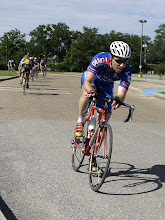Yes, Virginia, there is a proper method to pedal.
I rec'd an email from my brother this morning. He sent me a link to bike fit article in Velonews - PROJECT PRUITT. The article series is following a guy named Tom LeCarner. He's a Velonews contributor, and obviously a very nice guy with a serious bike habit(not that there's anything wrong with that.) Unfortunately, his bike habit is being hampered by nagging problems that you can read about in Velonews.
Here's my position. This guy is a mess before and after the fit. Before the fit, he's an obvious mess evidenced by the excessive aberrant movement. After the fit, he's a not so obvious mess because he's not bouncing around on the saddle. He stopped moving because the bike fitters used external aids to block and control motion. This changes the way the rider appears on video, however, it hasn't changed the way his brain wants to make the body move. The underlying motor pattern has not changed. As the body tries to move against these blocks, fewer aberrant motions appear yet, increased joint shear forces lurk. In addition, there are technical concerns that will continue to feed this cycle of overuse injuries.
There is a school of thought that says ankle position does not matter in cycling. In fact, there is research to back it up**. However, if you have ever read research about cycling, you know that good information is a difficult animal to capture. There are so many things going on that research models are difficult to create. Here's what I do know. Regardless of ankle position, effective force cannot be generated at the bottom of the stroke unless the axis of rotation of the knee is vertically oriented over the bottom bracket and pedal at dead bottom center. At this point in time, the hip is transitioning from extension to flexion. It cannot contribute to force production because it's arc of motion is perpendicular to the arc of the pedal. Also, the ankle has the same predicament**. Therefore, the only joint to contribute to force production is the knee and for it to contribute effectively, the arc of motion created by this joint must overlie the arc of motion created by the pedal. This only occurs when the axis of rotation of the knee is directly vertical over the bottom bracket and pedal.
After the fit, the rider has stopped bouncing. However, his knee is several cm behind the bottom bracket. As a result, other compensatory changes have to occur to allow the body to continue to move in the circular patter created by the pedals. Yes, the pedals move in a circle.
**If ankle position doesn't matter, how should the body modulate muscle length of the gastrocnemius and hamstring? If ankle position doesn't matter, why is there a specific ankle position and method used by the brain to start the pedal stroke at dead bottom center or top dead center when inertia is not present?


0 Comments:
Post a Comment
<< Home